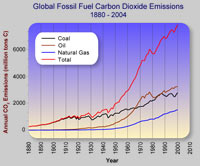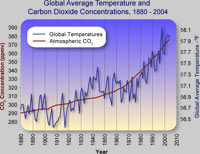Global Warming
What is Happening and How We Can Solve It
The Arctic is at the center of most discussions on climate change because warming is greatest there and because what happens in the Arctic has the potential to impact the rest of the Earth.
Within the past decade, the debate over climate change has shifted: scientists are no longer questioning if climate change is real or if human activities are the cause. Both of these facts are now well established. The 13 warmest years in the last 125 have all occurred since 1990, with 2005 being the hottest year in the record. As illustrated in the graphs, emissions of carbon dioxide from fossil fuels have increased greatly. Those increased emissions lead to rising concentrations of carbon dioxide in the atmosphere, which directly correlates with rising global temperatures. Increased temperatures on Earth will mean more drought, more fires, more frequent heat waves, melting glaciers, rising sea levels, and disappearing coastlines.
But despite such dire consequences, the most significant impacts of climate change are still within our power to resolve. By using less fossil fuel—either by changing our behaviors, developing more energy efficient technologies, or increasing our use of renewable energy sources such as photovoltaic (solar) panels or wind turbines which don’t release greenhouse gases—we will be taking crucial steps towards mitigating the effects of climate change. Further, actions by communities of all sizes—from small arctic towns to large American cities to entire countries in all corners of the world—to increase awareness about the results of our actions and to educate people on how to change their behaviors will foster a healthy environment for generations to come.
Credit: Dr. R. Max Holmes, Woods Hole Research Center for providing this text.
- WHOI's Global Warming Page
Find links to articles and news releases describing WHOI research on global warming, as well as a global warming Q&A with WHOI investigators. - Student Partners Project
The research being conducted by the Student Partners Project seeks to understand the consequences of global warming in the Arctic and how changes there will impact global climate.



